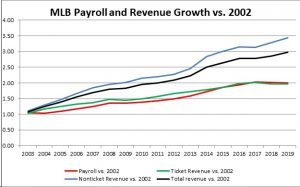Per the latest report from Ronald Blum of the Associated Press, payrolls across MLB fell from $4.22 billion in 2019 to $1.75 billion during the pandemic-shortened 2020 season. The Dodgers’ $98.6MM payroll, Blum notes, clocked in as the highest mark among the game’s 30 teams. The Yankees finished second with a payroll of $86.3MM.
Of course, the 60-game season meant prorating pay, dropping player salaries by approximately 63% from the full-scale amount. The totals given here mark a roughly 59% year-over-year decrease, suggesting payrolls would have increased had there been a full season. 2018 brought the first year-over-year decrease in payroll since 2010, as Blum reported at the time.
One complicating factor was a rise in buyout options. As Blum writes, “Buyouts of unexercised 2021 options came to $58.2 million, more than double the $26.9 million for buyouts of unexercised 2020 options, a sign of expense-cutting amid the revenue loss.” That’s not a surprise, given the sudden change in expected revenues without fans present, but it is noteworthy.
Parsing owners’ financial positions after this season’s revenue losses will continue to be a topic of discussion as free agency moves forward at its glacial pace. Without transparency from owners, the exact losses are difficult to ascertain. These numbers – presuming their accuracy – do serve as a significant data point, however.
The question of finances has been and will continue to be one of the sticking points between MLB and the MLBPA as the two sides near the expiration of the collective bargaining agreement. Transparency has been at the center of the debate, as owners have resisted the call from players to make their finances public. The Braves, as a publicly traded company, are the only team whose finances are made public in the form of quarterly reports, as Fangraphs’ Craig Edwards reviewed in early December. Of course, only so much can be gleaned from a single team’s financial numbers.

